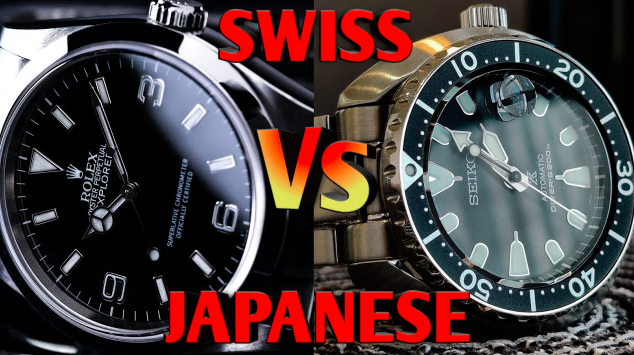Swiss Movement vs. Japanese Movement: A Comparative Guide

When it comes to high-quality watch movements, Swiss and Japanese options are often at the forefront of discussions among enthusiasts and collectors. Each has its own strengths and characteristics, shaped by the distinct traditions and technologies of their respective countries. This article compares Swiss movements and Japanese movements, exploring their features, advantages, and the nuances that differentiate them.
1. Overview of Swiss Movements
Swiss watch movements are renowned for their precision, craftsmanship, and long-standing heritage. Switzerland has been a leader in watchmaking for centuries, and Swiss movements are often considered the gold standard in the industry.
Key Characteristics:
Precision and Craftsmanship: Swiss movements are celebrated for their meticulous craftsmanship and precision. Swiss watchmakers employ advanced techniques and high-quality materials to ensure accuracy and durability.
Traditional Techniques: Many Swiss movements are handcrafted using traditional techniques passed down through generations. This focus on craftsmanship results in highly detailed and aesthetically pleasing movements.
Innovation and Technology: Switzerland is known for its innovative approach to watchmaking. Swiss movements often incorporate the latest technological advancements, such as advanced escapements and precision regulation systems.
Luxury and Prestige: Swiss movements are often associated with luxury and high-end brands. The Swiss watch industry has a reputation for producing prestigious timepieces, and Swiss movements play a crucial role in maintaining this image.
2. Overview of Japanese Movements
Japanese watch movements are known for their reliability, efficiency, and value for money. Japan has established itself as a major player in the watch industry, with a focus on precision and technological innovation.
Key Characteristics:
Accuracy and Reliability: Japanese movements are renowned for their accuracy and reliability. They often feature advanced quartz technology, which provides consistent and precise timekeeping.
Efficiency and Durability: Japanese movements are designed with efficiency in mind. They typically feature robust and durable components, making them suitable for a wide range of applications and ensuring long-term performance.
Technological Innovation: Japan is known for its technological advancements in watchmaking. Japanese movements often incorporate innovative features, such as kinetic energy storage and advanced quartz technology, which enhance their functionality.
Affordability and Value: Japanese movements offer excellent value for money. They are often more affordable than Swiss movements while still providing high levels of accuracy and reliability.
Read also: How are business statistics used by companies?
3. Comparing Swiss and Japanese Movements
Craftsmanship vs. Efficiency
Swiss movements are often praised for their traditional craftsmanship and aesthetic beauty. They represent a high level of artistry and skill, with many Swiss watches featuring intricate designs and hand-finished components. In contrast, Japanese movements focus on efficiency and functionality, emphasizing reliable performance and technological advancements over traditional craftsmanship.
Precision and Technology
Both Swiss and Japanese movements are known for their precision, but they achieve it through different means. Swiss movements often utilize sophisticated mechanical engineering and traditional techniques, while Japanese movements leverage advanced quartz technology and innovative features to ensure accurate timekeeping.
Luxury vs. Value
Swiss movements are frequently associated with luxury and high-end watch brands. The emphasis on craftsmanship and prestige contributes to the higher price points of Swiss watches. Japanese movements, on the other hand, are known for their value for money. They offer reliable and precise performance at a more accessible price, making them popular among a broader audience.
Innovation and Tradition
Swiss watchmakers are renowned for their long history and tradition, and this is reflected in the design and construction of their movements. Japanese watchmakers, while also embracing tradition, are often more focused on incorporating cutting-edge technology and efficiency into their movements. This approach results in a different set of innovations, such as quartz accuracy and kinetic energy storage.
4. Choosing Between Swiss and Japanese Movements
The choice between Swiss and Japanese movements depends on various factors, including personal preferences, budget, and desired features. Swiss movements are ideal for those seeking traditional craftsmanship, luxury, and prestige, while Japanese movements are suitable for those prioritizing reliability, technological innovation, and value for money.
Swiss Movements:
- Ideal for luxury and high-end watch enthusiasts.
- Appreciated for traditional craftsmanship and aesthetic design.
- Often used in prestigious and high-cost timepieces.
Japanese Movements:
- Ideal for those seeking reliable and accurate performance at a reasonable price.
- Valued for efficiency, durability, and technological innovation.
- Often found in a wide range of accessible and functional timepieces.
5. Conclusion
Both Swiss and Japanese movements offer exceptional qualities and cater to different needs and preferences. Swiss movements are celebrated for their craftsmanship, luxury, and innovation, while Japanese movements are known for their precision, efficiency swiss movement vs japanese movement and value. Understanding the differences between these two types of movements can help enthusiasts and buyers make informed decisions based on their priorities and preferences. Whether opting for the prestige of Swiss craftsmanship or the reliability of Japanese technology, both offer unique advantages in the world of watchmaking.



